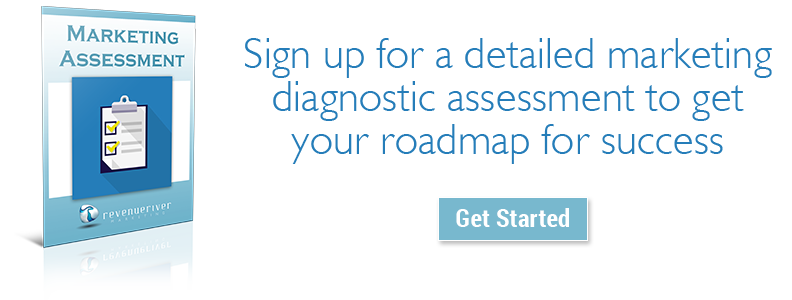
Have you ever wished you had a re-do button in life?
Wouldn’t it be great to be able to test out a couple of different punch lines for a joke to see which would get the most laughs? Or test out a couple of different ways to approach a difficult conversation to see which reduced the odds of you getting punched in the face?
Hindsight is 20/20, but if you knew how something was going to turn out, chances are you would have done it differently from the start.
Well, unfortunately, I’m not here to tell you that I invented a re-do button. But, fortunately for marketers, we do have the equivalent of a re-do button for inbound marketing strategy: A/B testing.
You can’t ever be 100% sure what is going to be a hit or miss in marketing, but you can make some educated guesses with research and strategy. You don’t have to lock yourself in to one approach and hope that it works; with A/B testing you can test out several approaches and ultimately take the one that performs the best and run with it.
Again, hindsight is 20/20. We may not have all the answers at the start of a campaign, but we can find the answers through A/B testing and, ultimately, we’ll find success too.
A/B Testing Musts
Knowing that we want to find success in our campaigns and we can do that through A/B testing, the important question at hand becomes a two-parter: 1) what should I be A/B testing and 2) how do I set up those A/B tests?
Here are a few key areas you should be A/B testing in your campaigns and some tips on how you can set these A/B tests up in HubSpot or any of your other marketing platforms.
1. Email
Email is a critical element for any sound promotional strategy. Because it’s so critical, it needs to perform well. And, unfortunately, the market is so unbelievably oversaturated with email that it’s really difficult to get it to perform well. That’s why A/B testing for email becomes an absolutely necessary weapon to have in your arsenal.
Things you should be A/B testing in email include subject lines, CTAs (buttons versus hyperlinks), plain text versus HTML templates, and send times/days.
To set up an A/B test for any of these elements within email, it’s important to keep the baseline consistent to really ensure you are getting accurate results. The control that you’ll want to keep consistent in this instance will be the lists you are sending these emails to.
You can take a list of the same group of contacts (whether they are the same persona, same lifecycle stage, etc.) and split it for the A/B test. Send one group an email with a different subject line than the other group and see which has a better open rate. Send one group an email that uses a plain text template and the other group an HTML template. Send one group an email with a hyperlinked CTA and one group an email with a button CTA and see which has a better click rate. The most important thing to keep in mind is that you absolutely cannot test all of these things at once in a single email; your test will be inconclusive and you won’t be able to tell what changed element actually contributed to better performance.
Pro tip: Using a tool like Seventh Sense does the A/B testing for you when it comes to finding optimal send times and days.
2. Landing Pages
Landing pages are another critical element in any inbound campaign. If you care at all about getting conversions, you care about landing pages. Everyone wants more leads, so getting your landing pages to perform the best that they can is an absolute must.
Things you should be A/B testing with landing pages include layout (form above or below the fold) and content.
To set up an A/B test for a landing page, HubSpot makes it really easy. You can choose to create a variation of the same page, make your changes to that variation, and HubSpot will then randomly choose who to show the different versions to. You can view each page’s performance metrics and decide which page is the winner of the test and make that the page that everyone sees moving forward.
Again, you’ll want to make sure the changes you are making are clear so you can test exactly what is causing a change in performance. Changing the position of the form is a great test to start with. Testing changes in content can become a bit trickier with landing pages, but if you want to do so you can test out different header copy, different page content such as video and copy variations, and different imagery. You can even go as far as testing completely different templates and layouts.
3. Forms
Forms are another important element to consider for conversions. If your form is too long or cumbersome, your conversions may decrease.
You can A/B test thelength of a form and the information you are collecting.
To do this, you must keep your baseline consistent again by testing the form on the same page that is promoting the same offer versus testing the forms on two different pages.
You can have one version of the form on the page for a period of time before switching the form to the other version of the form for the same length of time and compare the amount of submissions you received and the conversion rate to determine what the optimal form length and fields to collect are.
4. CTAs & Lead Flows
Calls-to-Action and lead flows are other element you should be A/B testing as they ultimately affect your conversion rates on your website, too.
You can A/B test different copy, different formats, different colors, different sizes, and different placements with CTAs and lead flows.
To set up A/B tests with CTAs, HubSpot has a native functionality that makes it easy to do, but there are also some A/B tests you can set up on your own with CTAs as well.
If you want to test small changes such as a different button color or the same design with different verbiage, you can have HubSpot set up a test variation for the CTA and randomly show one version to some visitors and the other version to other visitors so you can ultimately view performance metrics like click and conversion rates to see which one is more successful.
If you want to test things like different formats on a blog article or different placements (hyperlinked versus graphic CTA or placing in the middle of an article versus the end of an article) you will have to set those tests up yourself and monitor performance on your own.
For lead flows, you can create a lead flow and let it run as a pop up for a while and then switch it to a slide-in and let it run for the same period of time to see which gets you more conversions.
There are a lot of cool things you can (and should) be doing when it comes to A/B testing within your inbound marketing campaigns, but it’s important to keep the end in mind and know what you’re trying to achieve through the tests you are running. It can be easy to get carried away and want to test everything at once, but that won’t ultimately give you the results you’re looking for.
You can get answers to the questions you’ve been asking and find the success you’ve been seeking in your marketing campaigns, it just might take a couple of well-planned A/B tests to get there!

